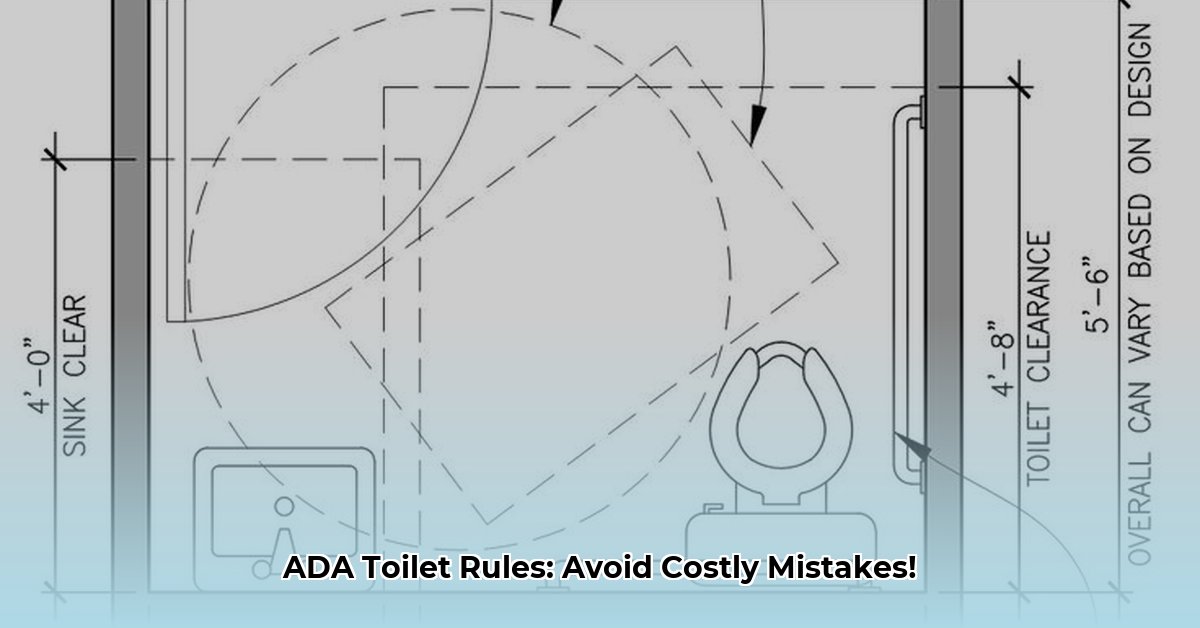Ensuring Accessibility in Your Bathroom
This guide provides clear, step-by-step instructions for understanding and implementing Americans with Disabilities Act (ADA) toilet clearance requirements. Proper toilet placement and clearances are crucial for creating a bathroom that is accessible and comfortable for everyone, particularly those with mobility challenges. This guide adheres to the 2010 ADA Standards for Accessible Design, but always consult the latest published standards and local codes for definitive requirements.
Understanding Key Measurements and Clearances
The 60-Inch Circle and Maneuvering Space
A 60-inch (1525 mm) diameter clear floor space around the toilet is essential for wheelchair users to maneuver and transfer comfortably. This measurement is taken from the side wall beside the toilet to the opposite wall, ensuring unobstructed space. While a circular shape is commonly visualized, the required area may be rectangular or slightly irregular as long as the minimum dimensions are met. The key is usable space free from obstructions. Fixtures like grab bars, toilet paper dispensers, and other dispensers may overlap into this space, provided they don’t impede wheelchair access.
Approach Direction
ADA standards accommodate both front and side approaches to the toilet. The 60-inch clearance ensures sufficient space regardless of the approach direction.
Measuring for Compliance: A Step-by-Step Guide
-
Locate the Centerline: Identify the exact center of the toilet.
-
Measure to the Side Wall: Measure 18 inches from the toilet centerline to the nearest side wall. This distance is often considered optimal for safe transfers.
-
Measure Clear Floor Space: Ensure a clear floor space of 60 inches wide by 56 inches deep in front of the toilet for parallel approach, or provide a T-shaped turning space as an alternative.
-
Measure Doorway Clearance: The minimum clear opening for the bathroom doorway should be 32 inches wide. Outward-swinging doors are generally preferred as they don’t obstruct clear floor space.
Essential Bathroom Features for Accessibility
Toilet Placement and Height
The ideal toilet placement is with its centerline 18 inches from the side wall. The top of the toilet seat should be between 17 and 19 inches from the floor for easy sitting and standing. While round bowls meet ADA standards, elongated bowls often provide enhanced comfort.
Grab Bars: Placement and Specifications
Two sturdy grab bars are required: one behind the toilet and one on the nearest side wall. Grab bars should be securely mounted and capable of supporting 250 pounds. Specific mounting locations and lengths ensure optimal leverage and support.
- Rear Grab Bar: 36 inches long, mounted 12 inches from the back wall and centered behind the toilet.
- Side Grab Bar: 42 inches long, mounted 33-36 inches above the floor.
Sink and Counter Accessibility
Sinks should have knee clearance of 27 inches high, 30 inches wide, and 19 inches deep. Countertops should not exceed 34 inches in height.
Turning Space Options
A 60-inch diameter turning circle is ideal for wheelchair users. If space is limited, a T-shaped turning space can suffice.
Additional Considerations for Enhanced Accessibility
Choosing ADA-Compliant Fixtures
Select toilets with easy-flush mechanisms and consider elongated bowls for added comfort. Choose grab bars with comfortable diameters (1-1/4 to 1-1/2 inches) and ensure they are securely mounted.
Retrofitting Challenges and Solutions
Retrofitting existing bathrooms can be challenging, but solutions such as wall-hung fixtures can free up valuable floor space. Consult with a qualified professional for advice on maximizing accessibility in tight spaces.
Exceeding Minimum Requirements
While meeting minimum ADA requirements is crucial, exceeding them can create an even more accessible and user-friendly bathroom. Consider longer grab bars and larger turning spaces if possible.
Summary of Key ADA Toilet Clearance Requirements
| Feature | ADA Requirement |
|---|---|
| Toilet Centerline to Side Wall | 18 inches |
| Clear Floor Space | 60-inch diameter circle (or 30″ x 48″ rectangle or T-shaped turning space) |
| Toilet Seat Height | 17-19 inches from floor to top of seat |
| Side Grab Bar | 42 inches long, 33-36 inches above floor |
| Back Grab Bar | 36 inches long, 33-36 inches above floor, centered |
| Toilet Paper Dispenser | Within reach from a seated position (generally no more than 19″ from toilet centerline) |
| Doorway Clearance | Minimum 32 inches wide, outward swing preferred |
Disclaimer
This guide provides general information about ADA toilet clearance requirements. It is not a substitute for professional advice. Consult with a qualified professional, such as a certified accessibility specialist or licensed contractor experienced in ADA compliance, and refer to the latest official ADA Standards for Accessible Design and local building codes for specific project requirements. Ongoing research and evolving best practices may lead to further refinements in accessibility standards. Staying informed about the latest recommendations is essential for creating truly inclusive spaces.
- How to Get Motor Oil Out of Clothes: Proven Methods & Step-by-Step Guide - April 25, 2025
- How to Get Mothball Smell Out of Clothes: A Complete Guide - April 25, 2025
- How to Get Highlighter Out of Clothes: Easy & Effective Stain Removal Guide - April 25, 2025










